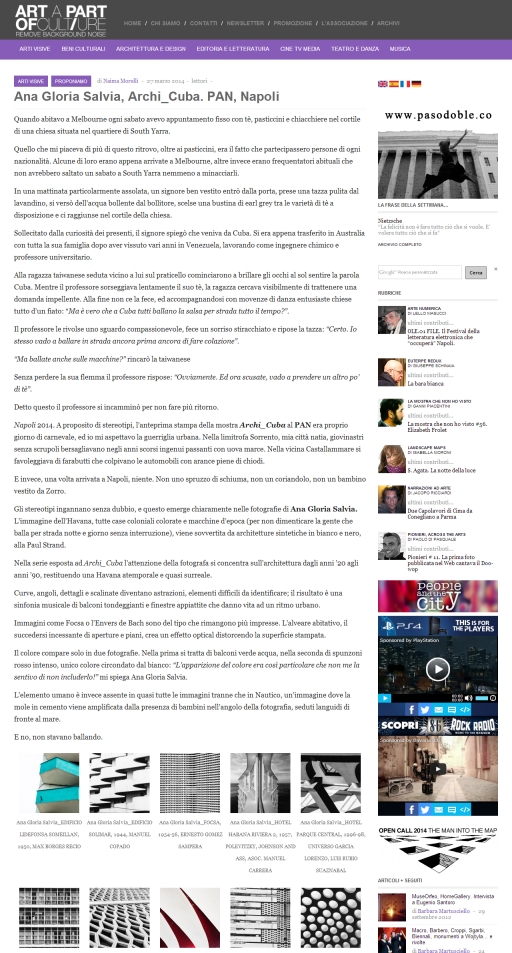
The Italian magazine Art a Part of Cult(ure) has just published my review of Ana Gloria Salvia’s exhibition “Archi_Cuba” at PAN, Naples
Read More
The Italian magazine Art a Part of Cult(ure) has just published my review of Ana Gloria Salvia’s exhibition “Archi_Cuba” at PAN, Naples
Read More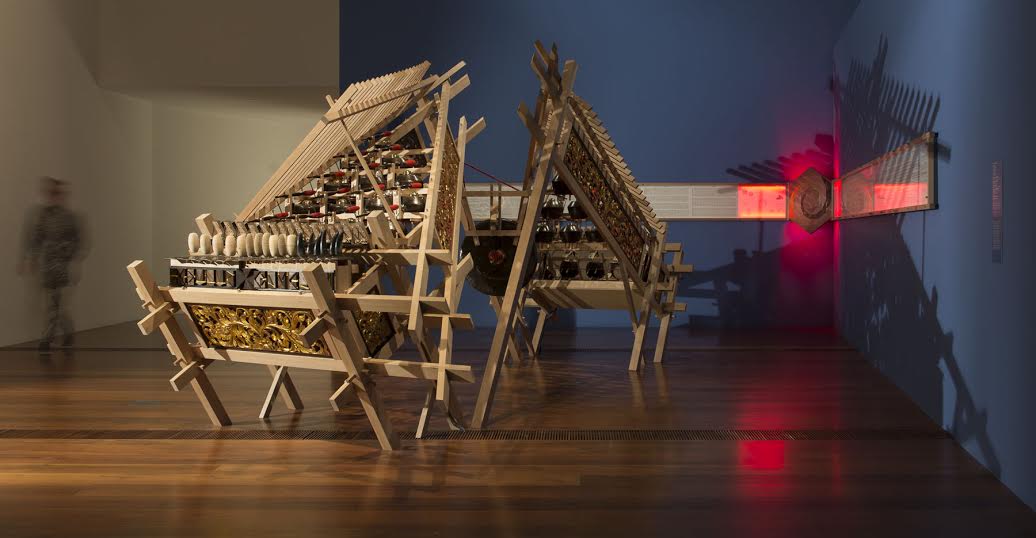
What the National Gallery of Victoria is trying to do with the Melbourne Now exhibition is to define the identity of Melbourne through its cultural practices, with a special focus on contemporary art.
I’m in Italy now, ironically writing my book about emerging artists in Melbourne, so I couldn’t visit the exhibition. Luckily my Australian friends and the artists that I have interviewed always keep me updated.
Some time ago I got a mail from artist Danius Kesminas, who told me about his new project with Slave Pianos for Melbourne Now, called Gamelan sisters (Sedulur gamelan). I posted some images, which gives you the feeling of this evocative machinery. On Slave Pianos’ website I find more information about it:
“Sedulur Gamelan (Gamelan Sisters) consists of two interlocking wooden structures that reconfigure elements of traditional Javanese architecture through the De Stijl philosophical principles of neoplasticism to create an abstraction of an 18th century double grand piano.
Read More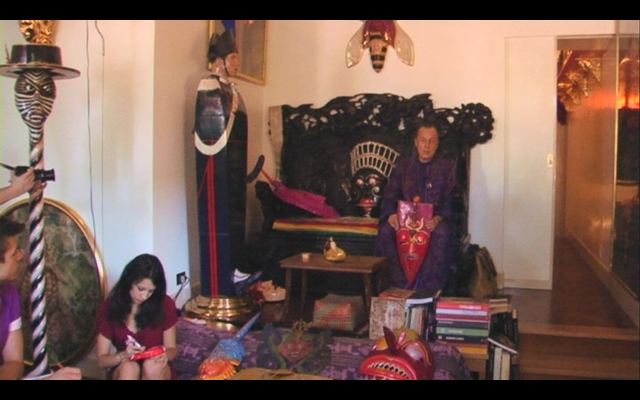
Three years ago Isabella Tirelli, artist and professor at the Art Academy in Rome started a video project called “Dialogo con l’artista”.
The project was based on collective interviews to artists in their studio and was realized under the direction of videomaker Leonardo Settimelli.
Tirelli gathered students and ex students from the Art Academy – I fell into the latter category – and we visited the studios of the most amazing artists in Rome.
The most notable visit for me was certainly the one to Luigi Ontani’s studio in Piazza Popolo.
I wrote about Luigi Ontani work before (for this blog, Artribune and I-Magazine Bali) and I obviously love his art. Who doesn’t afterall?
Once I was in Naples and, going down the Museo Madre’s stairs, I saw Ontani around the corner. I was wearing his typical blue silk suit and there were two guys literally throwing at his feet whispering:”Maestro… maestro…”. Even if Ontani’s physical presence is enough inspire devotion among many, the artist himself is much more down-to-earth than his public persona.
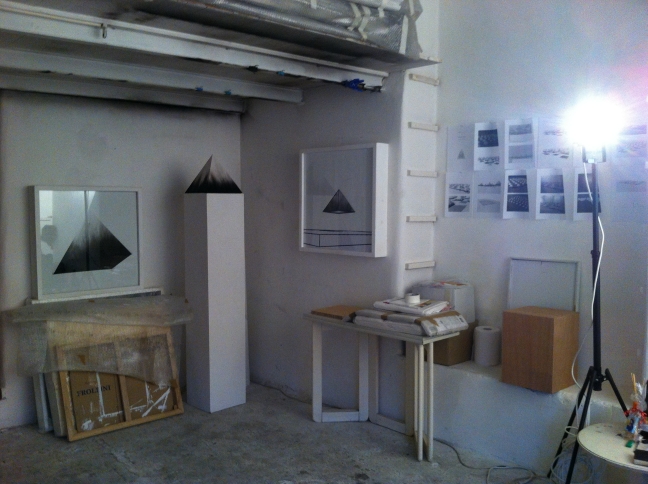
I recently visited the studio of artist Alessandro Cannistrà in San Lorenzo.
It consisted in a white, neat room, pretty bare, except for some books, stucked in an arch in the wall over the door, and a black sofa with some black hats on it.
“This is an original gaucho hat.” he said grabbing a wide-brimmed leather hat on top of the stack “I bought it in Argentina, during my artist residency in Buenos Aires”.
Alessandro has travelled quite a bit lately and he recently relocated in Rome. His work keep on travelling internationally through exhibition and fairs, that’s why his studio was almost empty at the moment.
My attention was attracted by some 3D reconstructions that were pinpointed on the wall.
“Is that what are you working on at the moment?” I asked
Alessandro explained me that he was working on these pyramids for his new solo exhibition at Toselli Gallery, in Milan, curated by Luca Tomìo. The title was “Oggetto di Pensiero”, namely “Object of thinking”, and will open on March 28.

Milan is a strange city. It’s not like Rome, where beauty is blatant and majestic.
Milan is more discreet, its beauties are hidden and only locals and curious people living there for a long time are aware of them.
Sometimes it feels like falling down the rabbit hole. What I mean is that you wouldn’t expect to find conceptual art, Dan Flavin to be precise, in a quiet suburbia at the end of the green line, Abbiategrasso (which in an English translation sounds like “Be fat”).
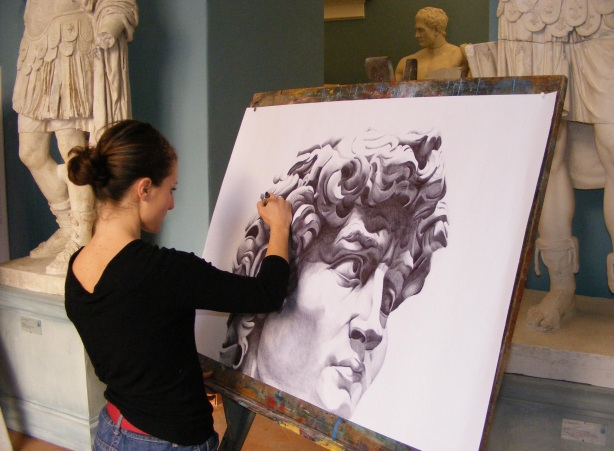
Ho recentemente ritrovato nei meandri di internet un mio articolo del 2008, riguardante gli esami di ammissione in tre delle più prestigiose Accademie di Belle Arti italiane, Roma, Napoli e Firenze. Al tempo mi recai nelle tre città per ovviare alla latitanza di informazioni sul web riguardo agli esami di ammissione, quello che trovai invece fu una sorta di specchio dell’Italia. Agli esordi del 2014 non penso che la situazione sia molto cambiata.
Viaggio tra le Accademie di Belle Arti d’Italia
Le informazioni sulle Accademie di Belle Arti Italiane sono scarse, i siti ufficiali poco aggiornati, le segreterie avare di informazioni, i forum a cui si rivolgono i ragazzi telegrafici. Abbiamo dato un’occhiata alle prove d’ammissione nelle Accademie di Belle arti di Firenze, Roma e Napoli: ecco il verdetto.
“Di dove sei?”
A farmi la domanda è una ragazza dall’aspetto un po’ alternativo, lunghi capelli castano chiaro e look hippie: “Io sono di Bologna, ho fatto il test di ammissione anche là, ma dicono che sono tutti raccomandati, e comunque è meglio farlo da più parti, perché se non entri hai sempre un’altra possibilità”.

C’era insomma un tempo dove il garage non era più quel luogo dove parcheggiavi la macchina e stipavi il televisore rotto.
C’era un tempo dove tutto era spartano e vivido. Basico. Come dire, un garage, un gallerista e la centralità dell’arte.
Grossomodo è così che l’arte moderna in Italia si è incamminata verso la contemporaneità.
Erano tempi mitici, dove le gallerie venivano allagate o nelle quali passeggiavano cavalli.
L’unico problema a quei tempi, piuttosto marginale per l’arte contemporanea, era dove parcheggiare l’automobile.
Adesso probabilmente la gente prende meno multe per divieto di sosta, ma quell’atmosfera grunge e sincera sembra essere sparita. Diversamente da altre città europee, a Roma e a Milano le alternative alle immacolate stanze dell’arte contemporanea sono veramente poche.
“L’arte contemporanea italiana è diventata sempre più istituzionalizzata. Non c’è traccia delle esperienze d’avanguardia degli anni sessanta e settanta. Sono sorpreso in particolare dagli artisti più giovani. Sono infatti proprio loro i primi a cercare di entrare in un sistema dell’arte già bello e pronto, e nemmeno si sforzano di immaginare soluzioni alternative. La stessa pratica artistica sembra essere diventata una faccenda secondaria”, afferma l’artista Alessandro Cannistrà.

Since no one cares about the 55th Venice Biennale anymore, I feel like sharing my definitive thoughts about my favourite pavilion, without anyone there to contradict me.
So, chart lovers, my favourite pavilion was the Indonesian one, curated by Rifky Effendy.
In no other pavilion the installations of different artists work so perfectly together. The show almost looked like one single artist and yet it encapsulated such a richness of discourses.
If you were at the Venice Biennale in October, you would have seen me wandering in the Arsenal looking for the Indonesian Pavillion.
I actually overshot the main entrance, so I came in by the back door.
It was dark inside, and there was a soft music that I didn’t notice in the first place. The music though ended up being a background noise influencing the entire experience of the pavilion.
The soundscape was actually by Solo composer Rahayu Supanggah, the guy who reinvented traditional Indonesian music. For the Biennale’s composition he was inspired by the theme of the pavilion, which was “Sankti”.
As the press release stated, Sankti is a sanskrit word that refers to the primordial cosmic energy and the personification of the divine, feminine creative energy, as well as indicating change and liberation.
The first dark-metal work I encountered immediately struck me with his expressive power.
A group of man wearing a Muslim hat were sitting at a table. One man was laying with his head on the table, like someone who had been shot or something. One man was pointing his finger to another gentleman, who looked baffled. If you looked better at these two figures and you would notice that their legs where stretched under the table so to touch each other.
But the figure that really stood out was a matriarch in traditional clothes, upright at the end of the table. She was bringing a hand at his chest like saying: “Who, me?”
A weird lamp was falling from the ceiling, almost touching the table. It was shaped like something between an octopus and a tropical fruit.
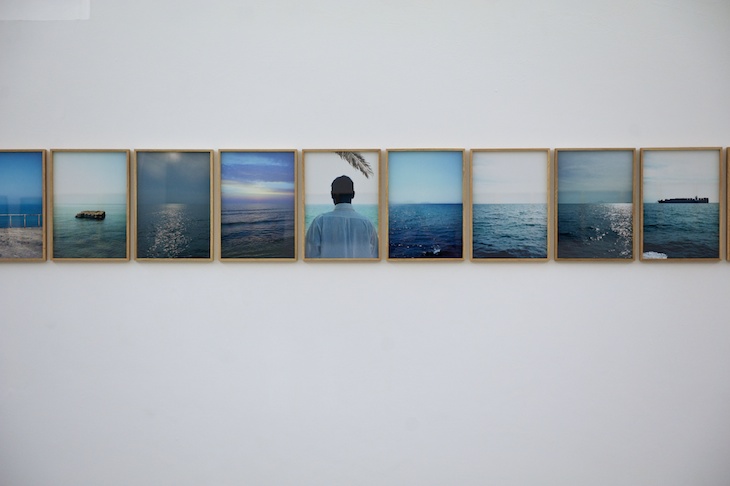
We have seen plenty of celebrations of the sea. The only subject that is as hackneyed as the sea is the sky. And love.
But really, to be innovative is not to talk about a new subject for the first time. To be innovative is to be able of talking about a corny subject in a new, or personal or moving way.
If you are a musician, go ask Ivano Fossati about it. If you are a painter, ask Piero Guccione. If you are a photographer, do what Monitor Gallery did. Go ask Antonio Rovaldi.